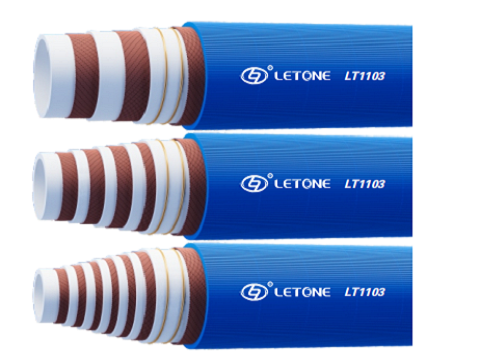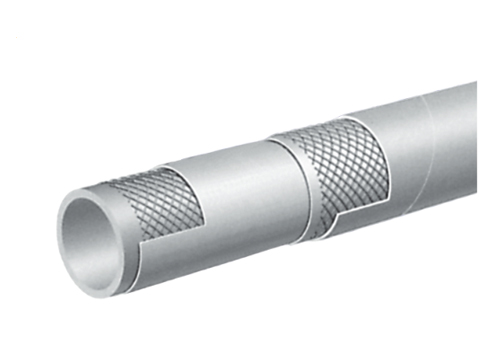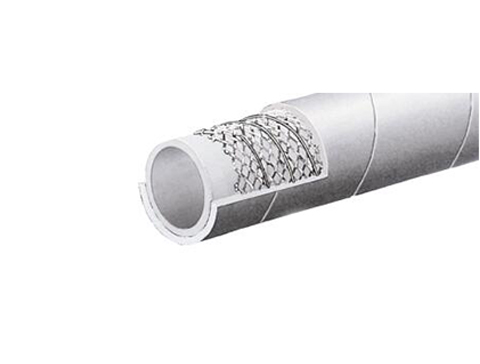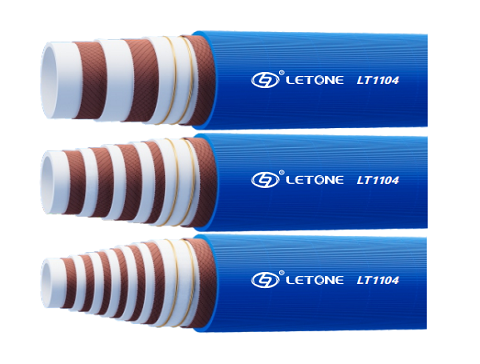Wire braided hydraulic hose: a flexible solution for dynamic bending scenarios
As the most widely used transmission component in hydraulic systems, wire braided hydraulic hoses have become "flexible joints" for dynamic operation scenarios such as engineering machinery and agricultural equipment with their unique structural design. Its core is composed of 2-6 layers of high-strength steel wire braided layers and synthetic rubber, and a three-dimensional mesh reinforcement structure is formed through a 45° cross-weaving process. This design gives the hose excellent bending performance-in the high-frequency swing of the excavator arm 20 times per minute, the four-layer steel wire braided hose can still maintain a bending radius less than 3D (multiples of the pipe diameter) while withstanding a working pressure of 35MPa. Verified by the SAE J517 standard test, its pulse life can reach more than 500,000 times, which is particularly suitable for hydraulic circuits that require continuous movement, such as injection molding machine clamping devices and port crane reel systems.
Wire-wound hydraulic hose: the steel backbone in the ultra-high pressure field
When the hydraulic system pressure exceeds the 50MPa threshold, the wire-wound hydraulic hose will show irreplaceable technical advantages. Using the spiral winding process, 4-6 layers of high-carbon steel wire are tightly wound at a golden angle of 54°44' to form a stress-bearing structure similar to the DNA double helix. Laboratory data shows that the burst pressure of the six-layer steel wire wound hose is as high as 210MPa. In ultra-high pressure scenarios such as shield machine propulsion systems and 10,000-ton hydraulic presses, its pressure fluctuation suppression ability is 40% higher than that of braided hoses. Even more groundbreaking is the innovation of the outer coating - through the composite protective layer of polyurethane + aramid fiber, the hose wear resistance index reaches the highest level of ISO 6945 standard, and even in the harsh environment of mining machinery gravel splashing, it can still guarantee a service life of more than 20,000 hours.
 Structural differences and application boundaries: Precisely matching working conditions
Although both are wire-reinforced hoses, there are essential differences in the technical characteristics of braided and wound structures:
• Pressure dimension: Braided hoses (up to 51MPa) are more suitable for medium and high pressure dynamic systems, and wound hoses (up to 100MPa) specialize in ultra-high pressure static scenarios
• Bending performance: The flexibility of the braided structure makes its bending life 3-5 times higher than that of the wound structure
• Pulse tolerance: The stress dispersion characteristics of the wound hose perform better in pulse tests
In the ship steering gear hydraulic system, we use a composite structure of three-layer braiding + double-layer winding, which not only meets the frequent bending requirements of 0.8m/s speed adjustment, but also can withstand the instantaneous pressure shock of 60MPa. This precise selection strategy has been successfully applied to complex working conditions such as wind power variable pitch systems and steel continuous casting equipment, helping customers reduce maintenance costs by 32%.
Scientific selection methodology: building a cost-effective hydraulic circuit
A three-dimensional evaluation model needs to be established to select a steel wire braided or wound hose:
Pressure spectrum analysis: calculate the system peak pressure × 1.25 times the safety factor, and the winding structure is recommended for scenes > 42MPa
Motion frequency calculation: the braided structure is mandatory for conditions with more than 10 bends per minute
Media compatibility verification: phosphate ester hydraulic oil needs to use EPDM inner rubber layer, and bio-oil-based media is suitable for NBR material
For example, in an automated stamping production line, we configure a four-layer winding hose for the 40MPa main oil circuit, and a six-layer braided hose for the manipulator unit that needs 360° rotation. Through the developed intelligent selection system, 12 parameters such as pressure, temperature, and bending frequency can be input to generate a complete solution including connector type and protection level, which increases the hose matching accuracy to 98%.
As a technical benchmark in the field of hydraulic transmission, we have a full range of product lines covering global standards such as SAE, EN, and GB, and have built an industry-leading pulse test platform (1 million times).
Structural differences and application boundaries: Precisely matching working conditions
Although both are wire-reinforced hoses, there are essential differences in the technical characteristics of braided and wound structures:
• Pressure dimension: Braided hoses (up to 51MPa) are more suitable for medium and high pressure dynamic systems, and wound hoses (up to 100MPa) specialize in ultra-high pressure static scenarios
• Bending performance: The flexibility of the braided structure makes its bending life 3-5 times higher than that of the wound structure
• Pulse tolerance: The stress dispersion characteristics of the wound hose perform better in pulse tests
In the ship steering gear hydraulic system, we use a composite structure of three-layer braiding + double-layer winding, which not only meets the frequent bending requirements of 0.8m/s speed adjustment, but also can withstand the instantaneous pressure shock of 60MPa. This precise selection strategy has been successfully applied to complex working conditions such as wind power variable pitch systems and steel continuous casting equipment, helping customers reduce maintenance costs by 32%.
Scientific selection methodology: building a cost-effective hydraulic circuit
A three-dimensional evaluation model needs to be established to select a steel wire braided or wound hose:
Pressure spectrum analysis: calculate the system peak pressure × 1.25 times the safety factor, and the winding structure is recommended for scenes > 42MPa
Motion frequency calculation: the braided structure is mandatory for conditions with more than 10 bends per minute
Media compatibility verification: phosphate ester hydraulic oil needs to use EPDM inner rubber layer, and bio-oil-based media is suitable for NBR material
For example, in an automated stamping production line, we configure a four-layer winding hose for the 40MPa main oil circuit, and a six-layer braided hose for the manipulator unit that needs 360° rotation. Through the developed intelligent selection system, 12 parameters such as pressure, temperature, and bending frequency can be input to generate a complete solution including connector type and protection level, which increases the hose matching accuracy to 98%.
As a technical benchmark in the field of hydraulic transmission, we have a full range of product lines covering global standards such as SAE, EN, and GB, and have built an industry-leading pulse test platform (1 million times).







